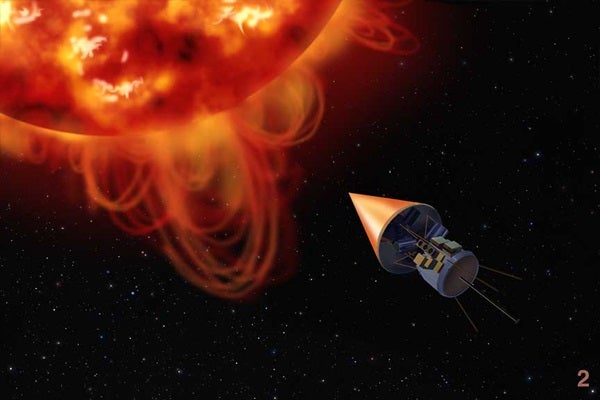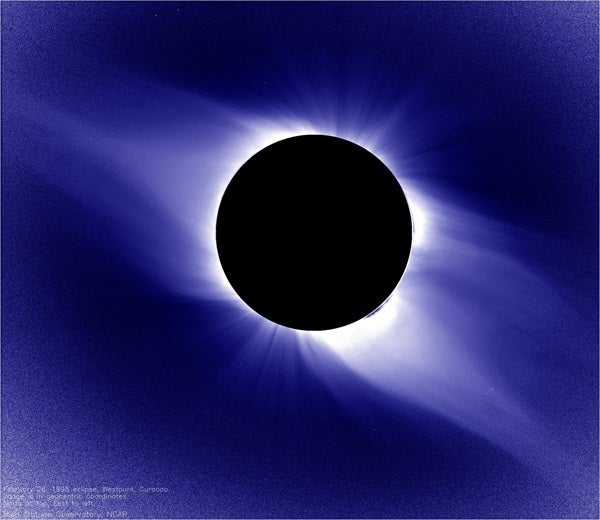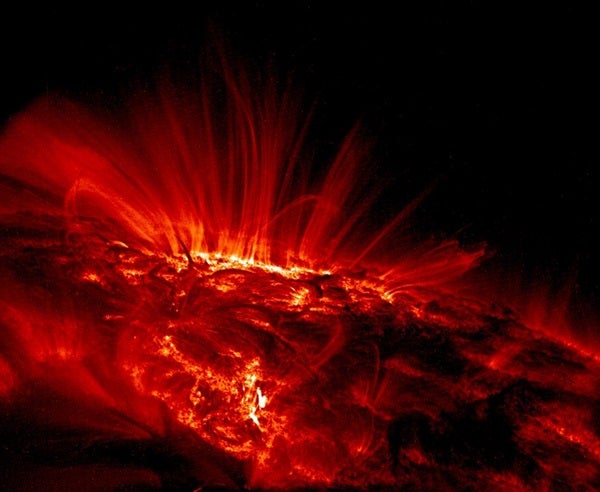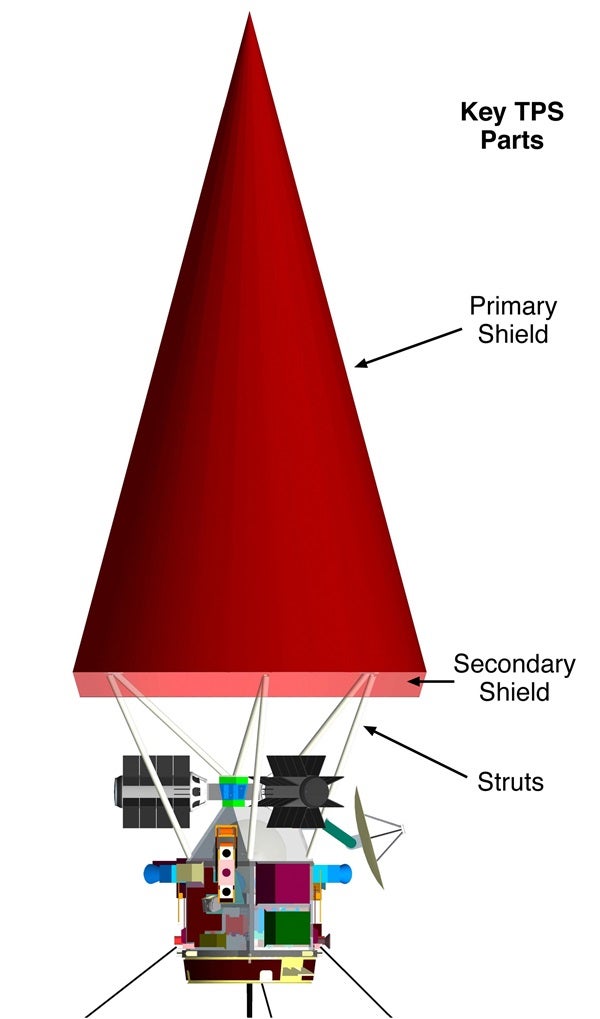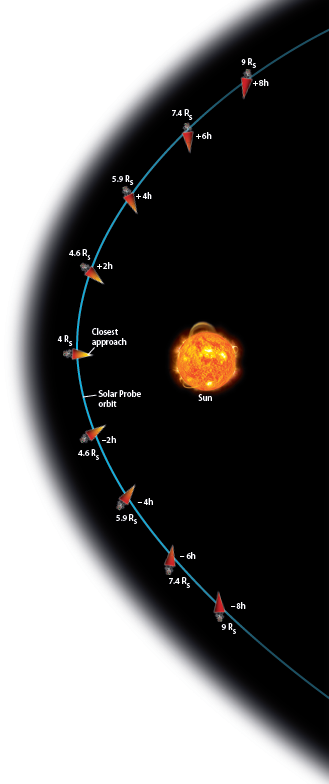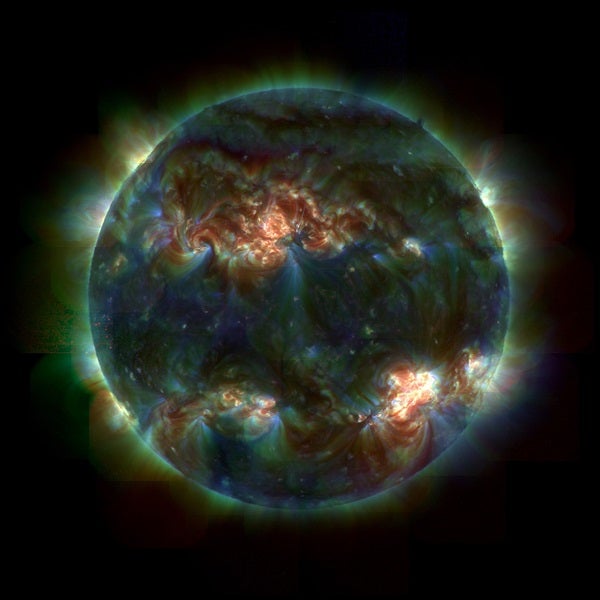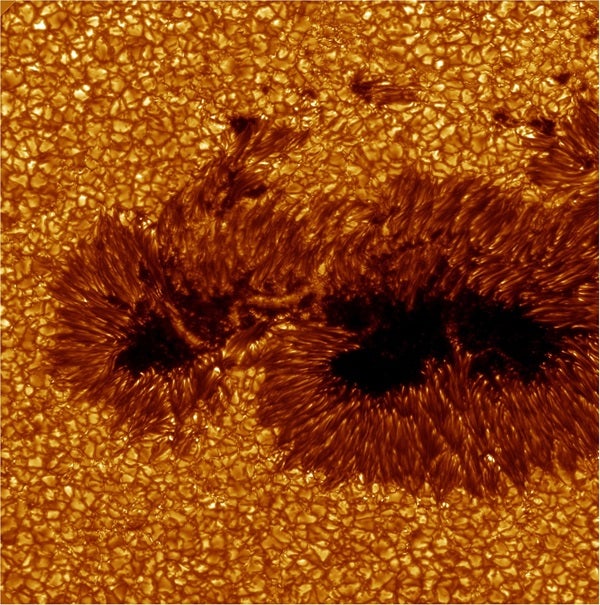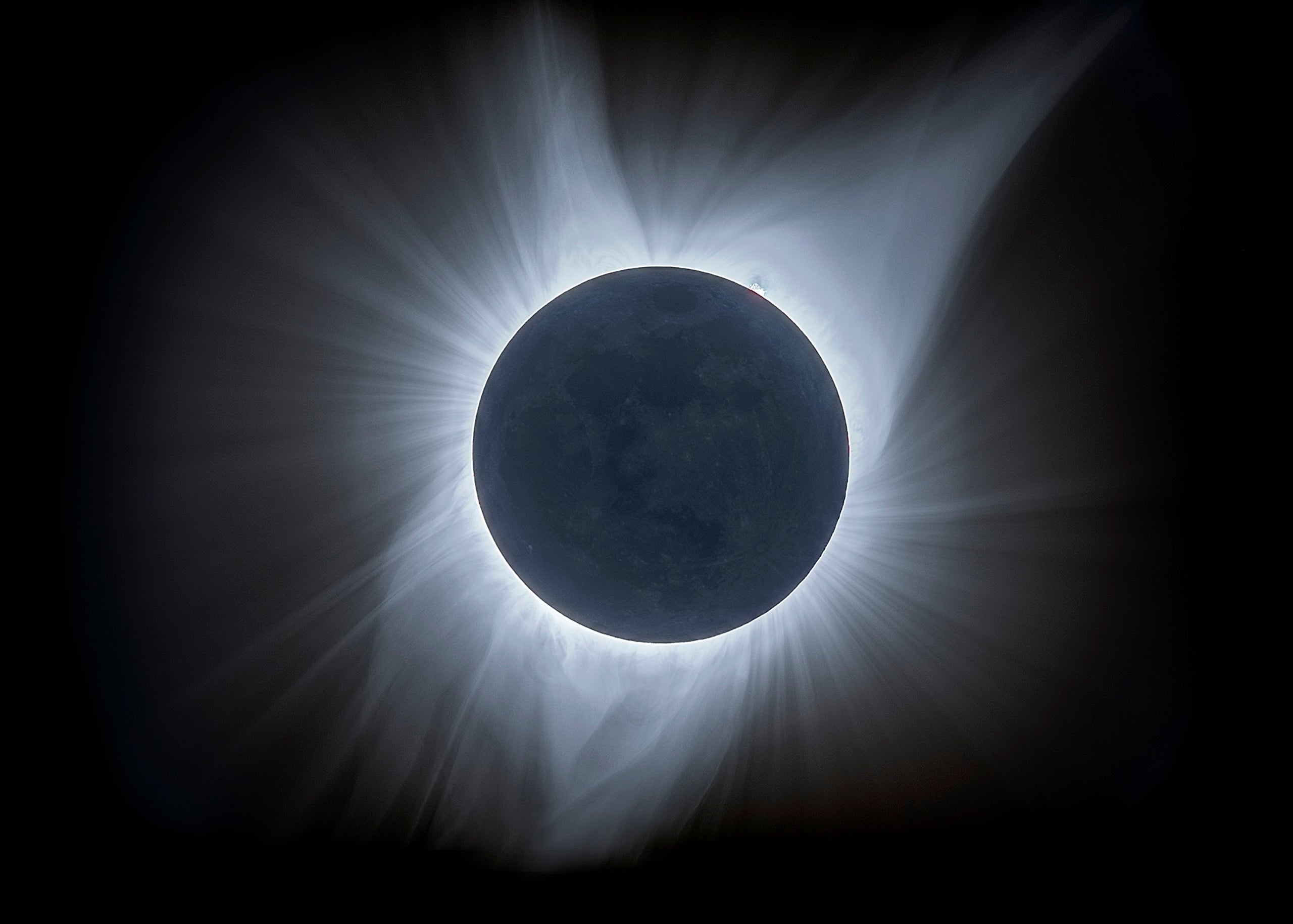This article originally appeared in the December 2006 issue of Astronomy. The mission is now known as Solar Probe Plus, and will launch in 2018. See NASA’s mission page for updated details.
One day — perhaps as early as 2014 — a spacecraft will depart Earth on a voyage of solar exploration. Measuring 8.9 feet (2.72 meters) across and 30.8 feet (9.4m) long, Solar Probe would encounter solar-corona temperatures averaging 3,600,000° Fahrenheit (2,000,000° Celsius) as it passes within 1.3 million miles (2.1 million kilometers) of the Sun’s surface.
This mission would answer some of the most vexing questions about our star: What heats the corona (the Sun’s outer atmosphere) to millions of degrees? How does the corona transition into the supersonic outflow of ionized gas known as the solar wind?
To the Sun — finally
The Sun remains our solar system’s only unvisited realm, half a century after the Space Age began. We’ve sent probes to all the planets, and Voyagers 1 and 2 are now exploring the solar system’s boundary, the heliosphere. But so far, no mission has gotten close to our star.
Technology finally exists to change that. Consider the immense design challenges for such a spacecraft. It must endure the extreme temperatures and radiation near the Sun. At Solar Probe’s planned orbit to within 3 solar radii of the Sun’s surface, the spacecraft must endure more than 3,000 times the Sun’s heat at Earth’s distance.
The space scientists and engineers planning the Solar Probe mission borrowed heat-resistant-material technology from missiles and the space shuttle to fashion a cone-shape thermal-protection system. The cone will shade the spacecraft as it penetrates the solar corona.
This proximity to the Sun will allow revolutionary measurements and images that will greatly expand our knowledge of the corona and solar wind. Solar Probe would make direct, on-the-scene measurements right where the Sun energizes its most hazardous solar particles. The spacecraft also would help us characterize, and even forecast, the changing radiation environment in which future space explorers will work.
Thanks to unprecedented advances in imaging, theory, and modeling, we now know more about the corona and the solar wind than ever before. And yet, solar physics’ two fundamental questions remain unanswered. The only way to find out why the corona is so much hotter than the Sun’s surface, and how the solar wind accelerates, is to collect data near the Sun.
The Solar Probe mission is rooted in the National Research Council’s 2003 decadal survey of solar and space physics. This study stressed the scientific importance of a solar mission and recommended that it be implemented as soon as possible.
In late 2003, NASA formed a Solar Probe Science and Technology Definition Team. The team’s official report, issued in September 2005, outlined a $1 billion mission that could launch in about a decade and provide an acceptably low-risk survey of the near-Sun environment. Funding of a mission of this scale will require special congressional appropriations.
If NASA and Congress fund Solar Probe, it stands to become the first spacecraft to venture into the inner heliosphere, where the solar wind is born. Through direct measurement and imaging of the region’s plasma, energetic particles, and fields, Solar Probe would provide the data needed to solve the twin mysteries of coronal heating and solar-wind acceleration.
Keeping Solar Probe cool
At its closest approach to the Sun, Solar Probe will endure solar energy much more intense than at Earth. The design and evaluation of a thermal-protection system (TPS) that will shield the spacecraft in this environment are the central foci of the Solar Probe team’s efforts.
The planned TPS consists of three components. The primary heat shield is a hollow cone about 9 feet (2.7m) in diameter and 17 feet (5.1m) tall made of carboncarbon composite with a ceramic coating. This shield protects the sensitive instruments and spacecraft subsystems from direct exposure to solar radiation.
The secondary shield is a disk of carbon-foam layers encased in a carboncarbon jacket and attached to the primary shield’s base. It insulates the instruments from the primary shield, which will reach temperatures approaching 3,000° Fahrenheit (1,650° Celsius) at perihelion (Solar Probe’s closest approach to the Sun).
The third component consists of the carbon-carbon attachment struts. They support the TPS and separate it from the spacecraft bus. The separation prevents the secondary shield heat from reaching the bus while providing maximum stability.
Mission scientists conducted thermal analysis using computer models of the TPS, combined with experimental testing of candidate materials. The tests demonstrated the TPS can maintain spacecraft systems at their normal operating temperatures — less than 120° F (49° C) — even during closest approach to the Sun.
During the proposed — and still to be funded — second phase, further testing of TPS materials and components will be performed, and a full-scale prototype will be fabricated, assembled, and tested.
One tough spacecraft
Solar Probe is a gyroscope-stabilized vehicle designed to survive and operate in intense heat. Its most prominent feature is the cone. Twenty days before closest approach, when Solar Probe is near Venus’ orbital distance, the craft’s thrusters will turn the cone toward the Sun. This providesthe protective shadow for the spacecraft bus and instruments. Solar Probe will retain this orientation throughout its encounter.
The instrument package includes instruments both for direct measurement of the solar environment and for remote-sensing observations of coronal structures. Most of the instrument package will be mounted safely inside the heat-protected spacecraft body. Three instruments, however — a fast-ion analyzer, a fast-electron analyzer, and an ion-composition analyzer — will be on a movable arm. This platform will extend instruments out to nearly the cone’s edge then retract them incrementally as the spacecraft approaches the Sun and the “safe zone” becomes smaller. Instruments on the arm will gather data just inside the edge of the thermal-protection system’s shade. Meanwhile, a retractable, heat-resistant imaging periscope will intermittently poke out beyond the shadow for quick views of the solar wind’s source regions.
Why we need to get close
Thanks to years of observations coupled with complex modeling and sophisticated theoretical research, scientists already have a general picture of how the Sun’s corona and the solar wind operate. They know that at times of lower solar activity, the solar wind has two components: a dominant, steady, high-speed wind and a more variable, low-speed wind. Each emanates from specific coronal zones.
As solar activity increases to solar maximum, this orderly configuration breaks down into a complex mixture of fast and slow winds from all areas of the corona. The energy that heats the corona and drives the wind manifests itself as motions of plasma within and around the Sun. Magnetic fields channel, store, and then dissipate these plasma motions. Heliophysicists believe waves, instabilities, magnetic reconnections, and turbulence — all operating on vast scales — play roles in coronal heating and solar-wind acceleration.
Scientists now want to know the geometry and dynamics of the expanding magnetic fields and particle distributions that lie at the sources of the fast and slow solar winds. Solar Probe will trace the energy flow that heats the corona and accelerates the solar wind. It also will determine what mechanisms accelerate and transport these charged particles around the Sun.
As a bonus, Solar Probe’s unique path close to the Sun will answer some questions about the size and mass distribution of mysterious dust grains orbiting near the Sun. This dust, believed to originate from comets and asteroids, interacts with the corona and may influence the solar wind and the formation of energetic particles.
Finally, even though Solar Probe will go where humans cannot, what scientists learn from the mission will play an important role in piloted missions to the Moon and Mars. On these expeditions (well beyond the protective shield of Earth’s magnetic field), astronauts may be exposed to intense blasts of the Sun’s energetic particles. Such events present serious threats to humans living and working beyond Earth.
Solar Probe will make the first direct measurements of the near-Sun region, sample the environment where solar plasma particles are energized, and identify the seed populations for these dangerous particles. The spacecraft also will provide critical data for predictive models that — along with solar and heliospheric monitoring — will enable scientists to forecast the spaceradiation environment in support of human exploration.
Solar Probe’s visit to a never-beforeexplored region of our solar system will answer questions that simply can’t be answered any other way. The answers will help space scientists understand what’s going on in a region that has awed and frightened humans since we first witnessed the Sun’s beautiful and mysterious corona during a total eclipse.
Moreover, as with any voyage into uncharted territory, Solar Probe’s journey also holds the promise of unanticipated discoveries — new mysteries that will challenge humanity’s ever-expanding knowledge of our home in the universe.

